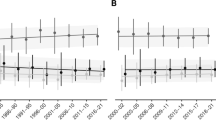Abstract
We examine the sub-field of philosophy of science using a new method developed in information science, Referenced Publication Years Spectroscopy (RPYS). RPYS allows us to identify peak years in citations in a field, which promises to help scholars identify the key contributions to a field, and revolutionary discoveries in a field. We discovered that philosophy of science, a sub-field in the humanities, differs significantly from other fields examined with this method. Books play a more important role in philosophy of science than in the sciences. Further, Einstein’s famous 1905 papers created a citation peak in the philosophy of science literature. But rather than being a contribution to the philosophy of science, their importance lies in the fact that they are revolutionary contributions to physics with important implications for philosophy of science.

Similar content being viewed by others
References
Barth, A., Marx, W., Bornmann, L., & Mutz, R. (2014). On the origins and the historical roots of the Higgs boson research from a bibliometric perspective. The European Physical Journal Plus, 129(6), 1–13. doi:10.1140/epjp/i2014-14111-6.
Bornmann, L., & Daniel, H.-D. (2008). What do citation counts measure? A review of studies on citing behavior. Journal of Documentation, 64(1), 45–80. doi:10.1108/00220410810844150.
Bornmann, L., & Marx, W. (2013). The proposal of a broadening of perspective in evaluative bibliometrics by complementing the times cited with a cited reference analysis. Journal of Informetrics, 7(1), 84–88. doi:10.1016/j.joi.2012.09.003.
Boyack, K. W., & Klavans, R. (2010). Co-citation analysis, bibliographic coupling, and direct citation: Which citation approach represents the research front most accurately? Journal of the American Society for Information Science and Technology, 61(12), 2389–2404.
Curd, M., & Psillos, S. (Eds.). (2014). The Routledge companion to philosophy of science (2nd ed.). London: Routledge.
De Solla Price, D. J. (1963). Little science, bigscience. Frankfurt am Main: Suhrkamp-Taschenbuch—Wissenschaft 48. New York: Columbia University Press.
Frank, P. (1949). Modern science and its philosophy. Cambridge: Harvard University Press.
Garfield, E. (1963). Citation indexes in sociological and historical research. American Documentation, 14(4), 289. doi:10.1002/asi.5090140405.
Garfield, E. (1987). A different sort of great-books list: The 50 twentieth-century works most cited in the arts and humanities citation index, 1976–1983. Current Contents, 16, 101–105.
Garfield, E. (2001). From computational linguistics to algorithmic historiography (Lazerow Lecture). In Paper presented as part of a panel on “knowledge and language”: Building large-scale knowledge bases for intelligent applications, University of Pittsburgh.
Garfield, E., Pudovkin, A. I., & Istomin, V. S. (2003). Why do we need algorithmic historiography? Journal of the American Society for Information Science and Technology, 54(5), 400–412.
Gutting, G. (2009). What philosophers know: Case studies in recent analytic philosophy. Cambridge: Cambridge University Press.
Kostoff, R. N., & Shlesinger, M. F. (2005). CAB: Citation-assisted background. Scientometrics, 62(2), 199–212.
Leydesdorff, L. (2010). Eugene Garfield and algorithmic historiography: Co-words, co-authors, and journal names. Annals of Library and Information Studies, 57(3), 248–260.
Leydesdorff, L., Bornmann, L., Marx, W., & Milojevic, S. (2014). Referenced Publication Years Spectroscopy applied to iMetrics: Scientometrics, Journal of Informetrics, and a relevant subset of (JASIST). Journal of Informetrics, 8(1), 162–174. doi:10.1016/j.joi.2013.11.006.
Marx, W., & Bornmann, L. (2014). Tracing the origin of a scientific legend by reference publication year spectroscopy (RPYS): The legend of the Darwin finches. Scientometrics, 99(3), 839–844. doi:10.1007/s11192-013-1200-8.
Marx, W., Bornmann, L., Barth, A., & Leydesdorff, L. (2014). Detecting the historical roots of research fields by reference publication year spectroscopy (RPYS). Journal of the American Society of Information Science and Technology, 65(4), 751–764.
Merton, R. K. (1965). On the shoulders of giants. New York: Free Press.
Merton, R. K. (1968). On the history and systematics of sociological theory. In R. K. Merton (Ed.), Social theory and social structure (Enlarged ed.). New York: The Free Press.
Reisch, G. A. (2005). How the Cold War transformed philosophy of science: To the icy slopes of logic. Cambridge: Cambridge University Press.
Rescher, N. (2006). The Berlin school of logical empiricism and its legacy. Erkenntnis, 64(3), 281–304.
Simonton, D. K. (2004). Creativity in science: Chance, logic, genius, and zeitgeist. Cambridge: Cambridge University Press.
Van Raan, A. F. J. (2000). On growth, ageing, and fractal differentiation of science. Scientometrics, 47(2), 347–362.
Worrall, J. (1989). Structural realism: The best of both worlds? Dialectica, 43(1–2), 99–124.
Wray, K. B. (2010). Philosophy of science: What are the key journals in the field? Erkenntnis, 72(3), 423–430.
Ziman, J. (2000). Real Science: What it is and what it means. Cambridge: Cambridge University Press.
Author information
Authors and Affiliations
Corresponding author
Rights and permissions
About this article
Cite this article
Wray, K.B., Bornmann, L. Philosophy of science viewed through the lense of “Referenced Publication Years Spectroscopy” (RPYS). Scientometrics 102, 1987–1996 (2015). https://doi.org/10.1007/s11192-014-1465-6
Received:
Published:
Issue Date:
DOI: https://doi.org/10.1007/s11192-014-1465-6




